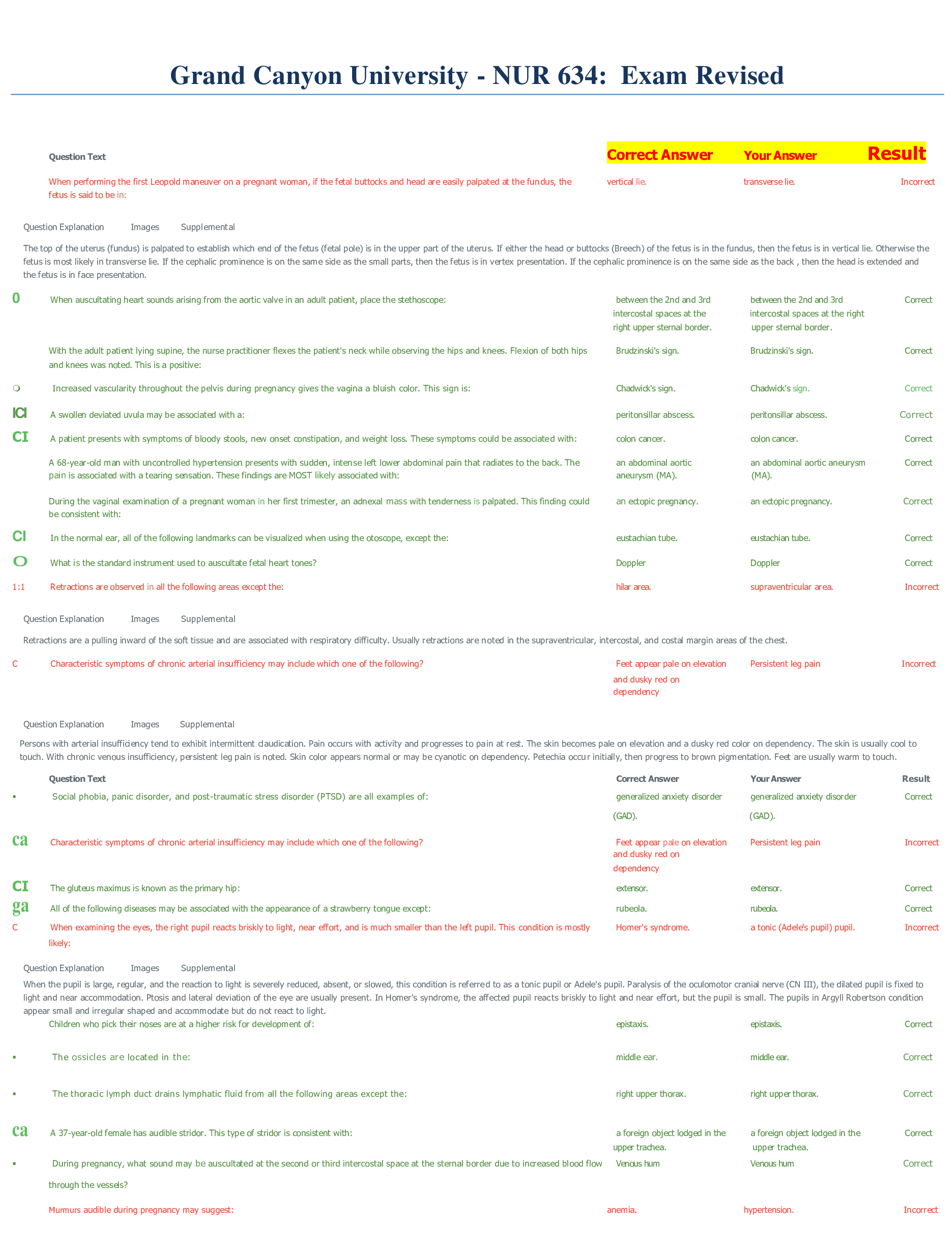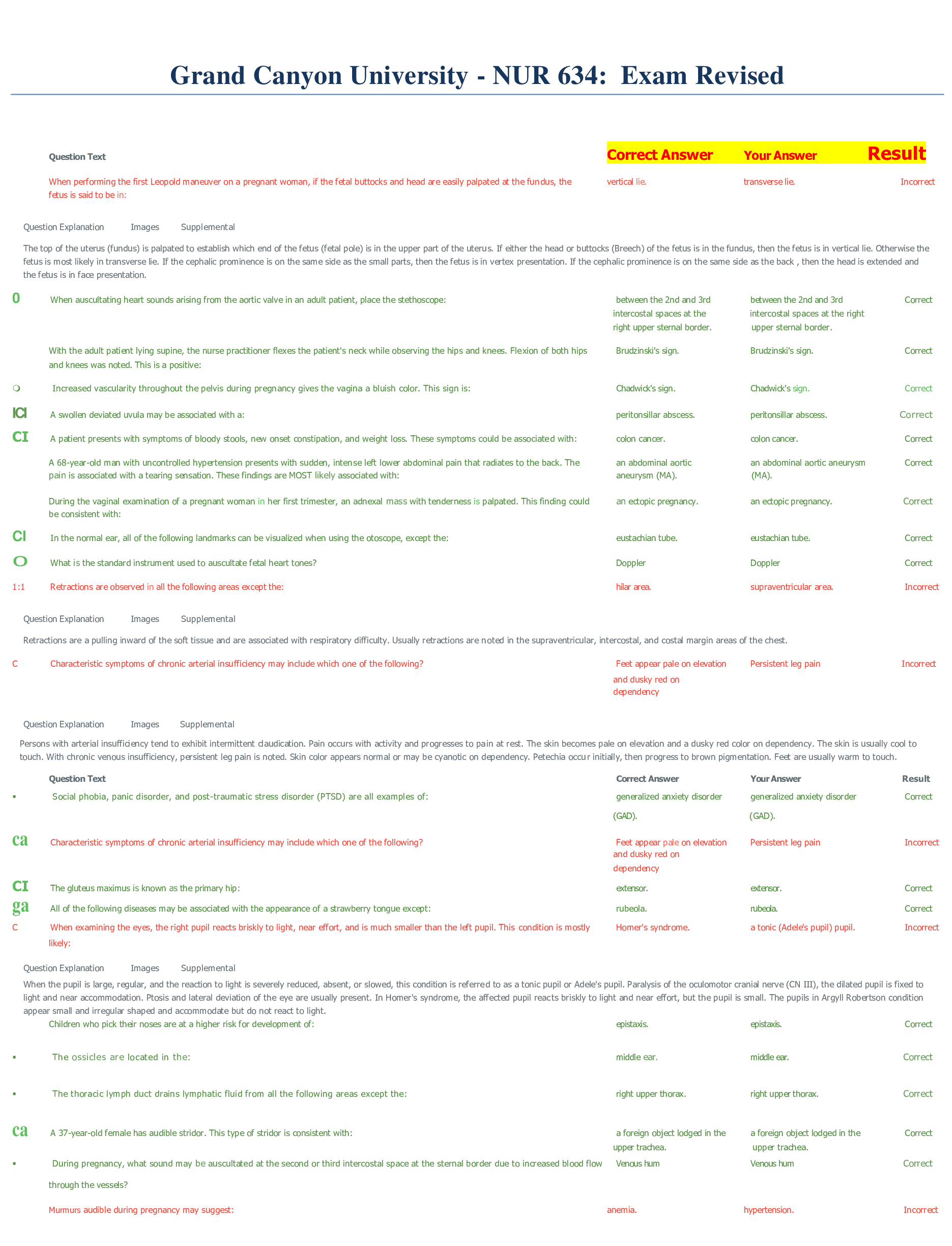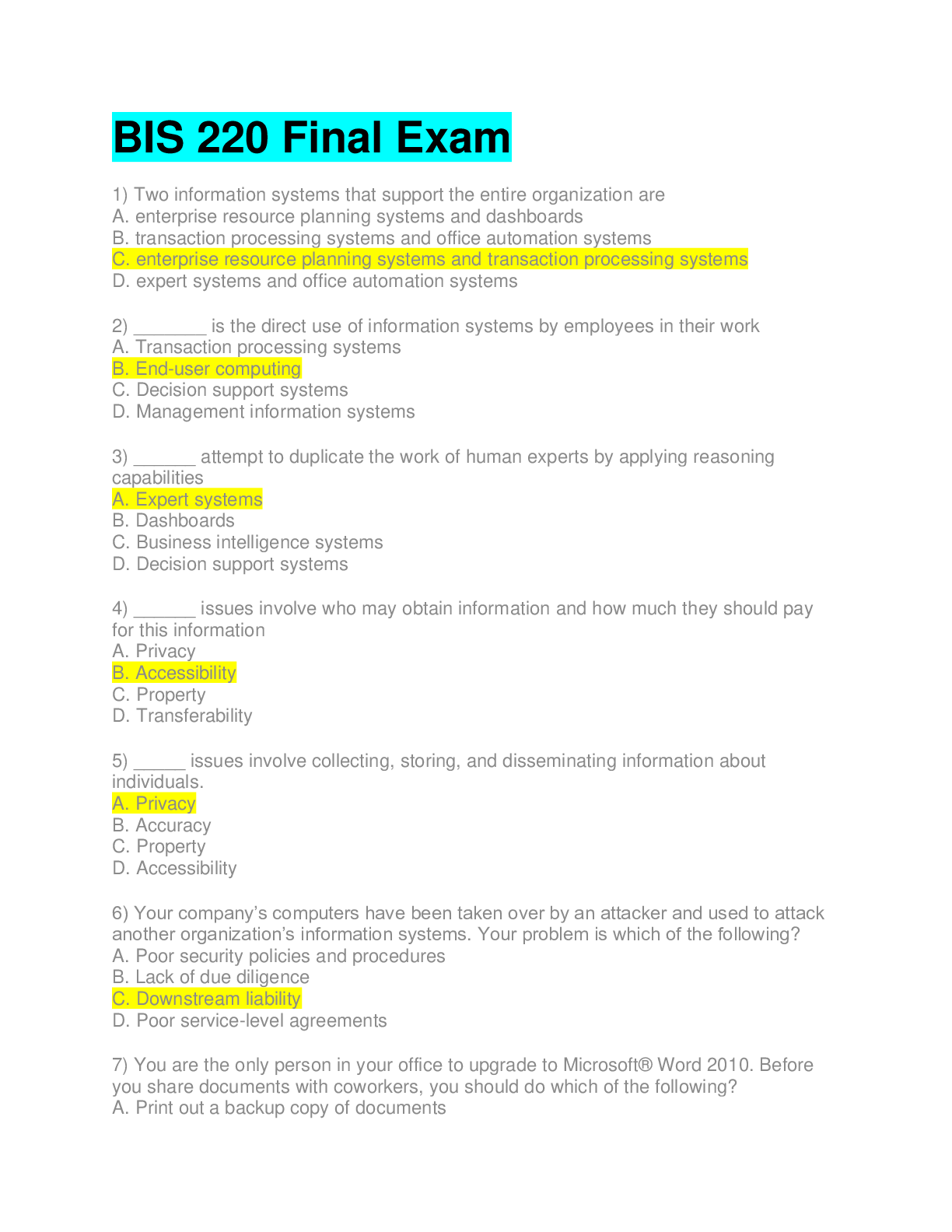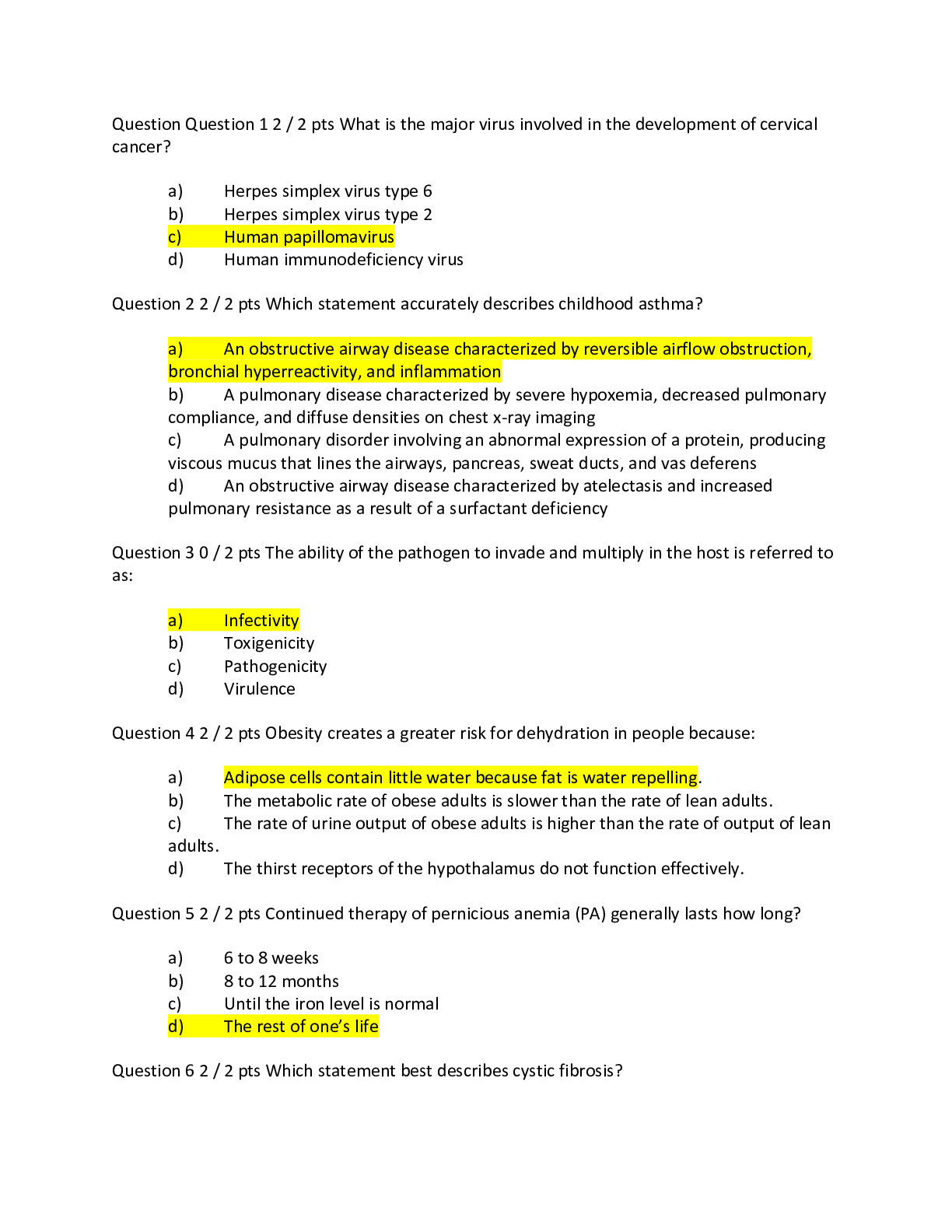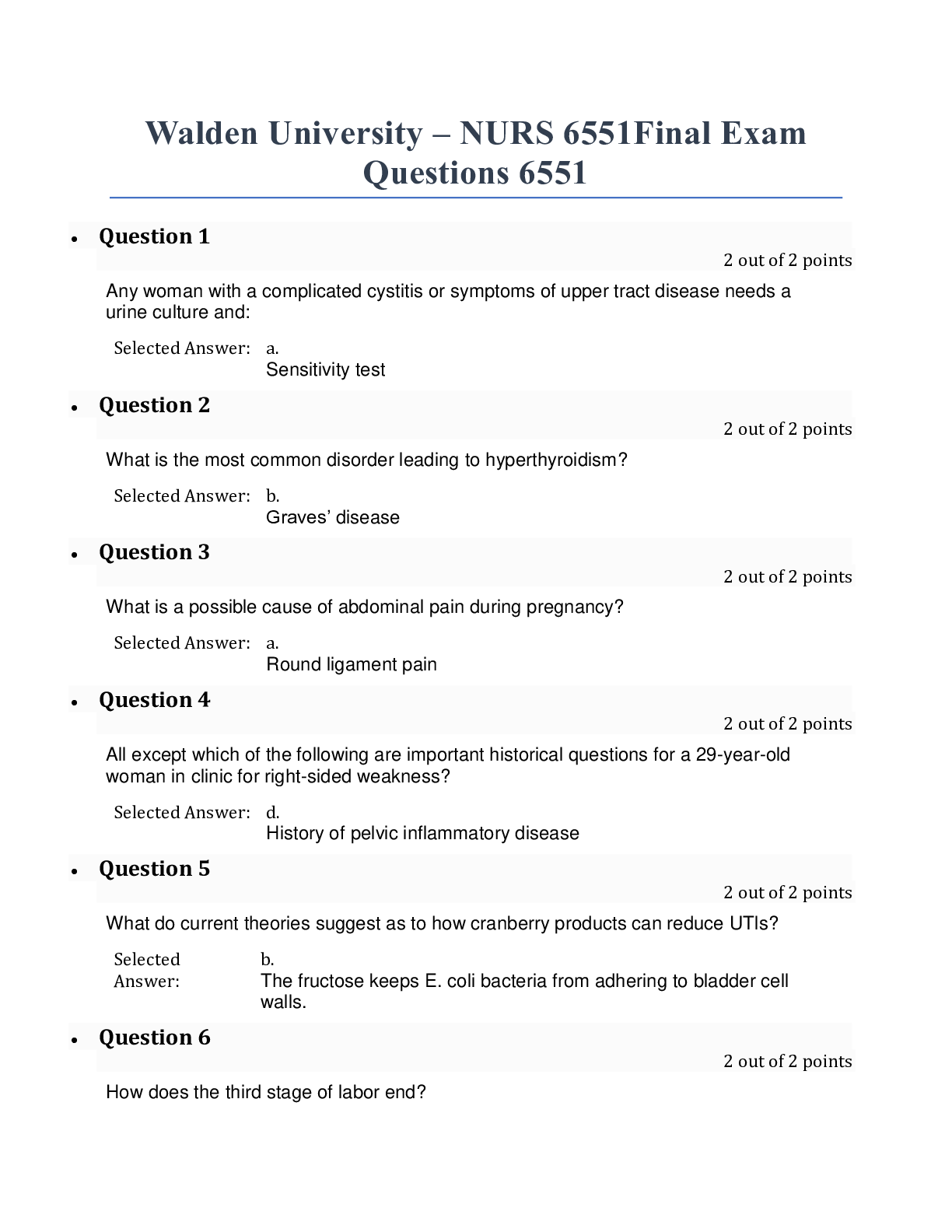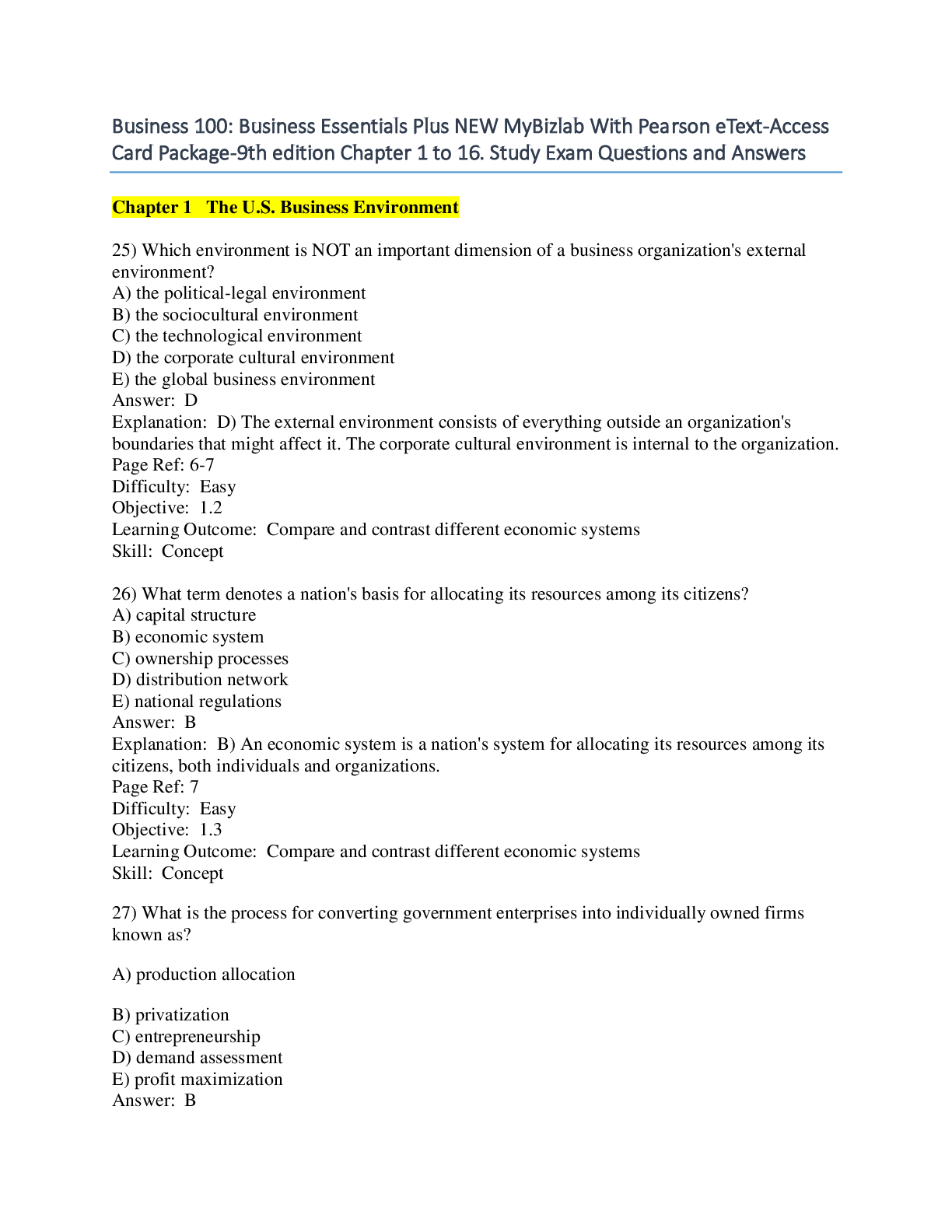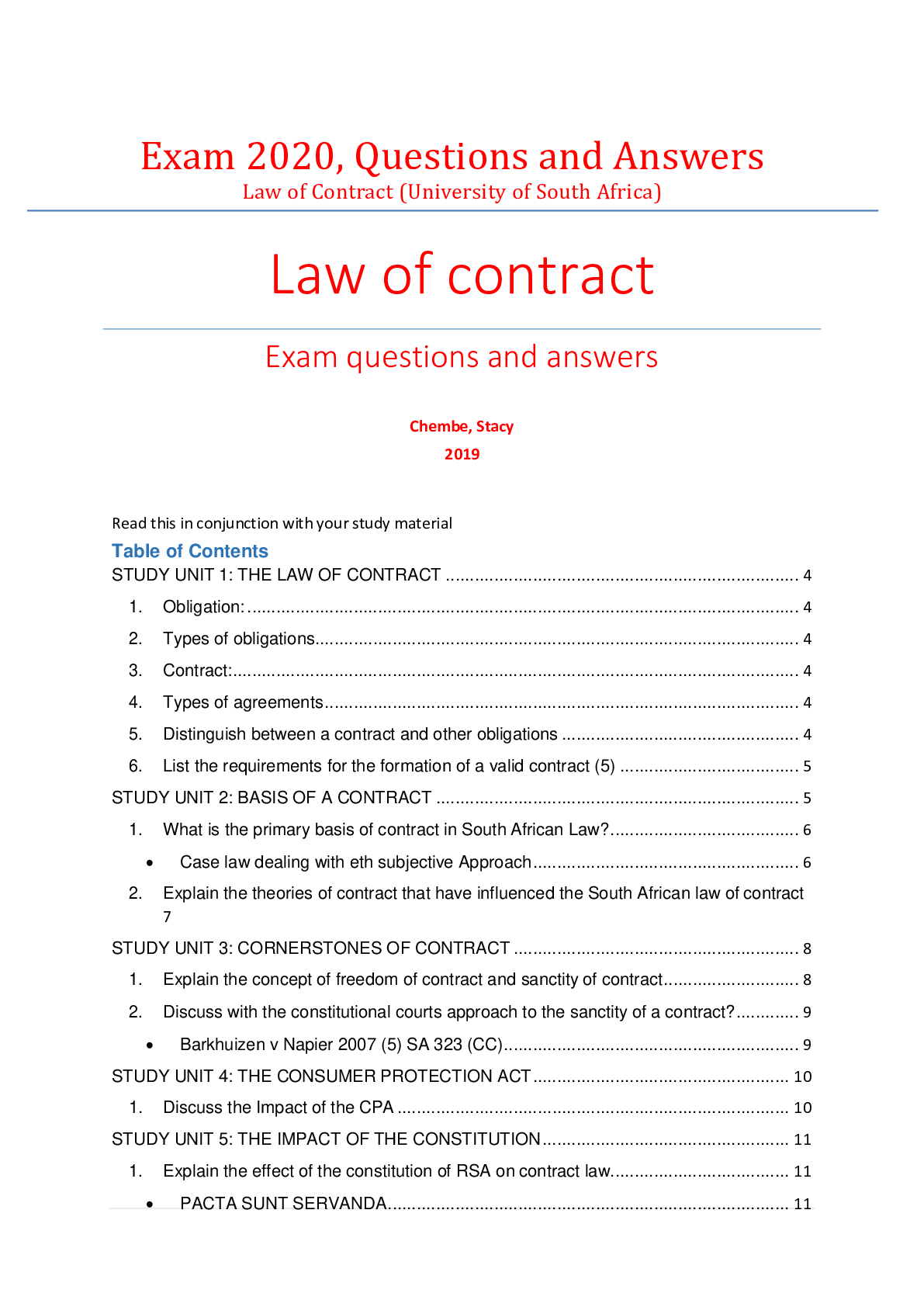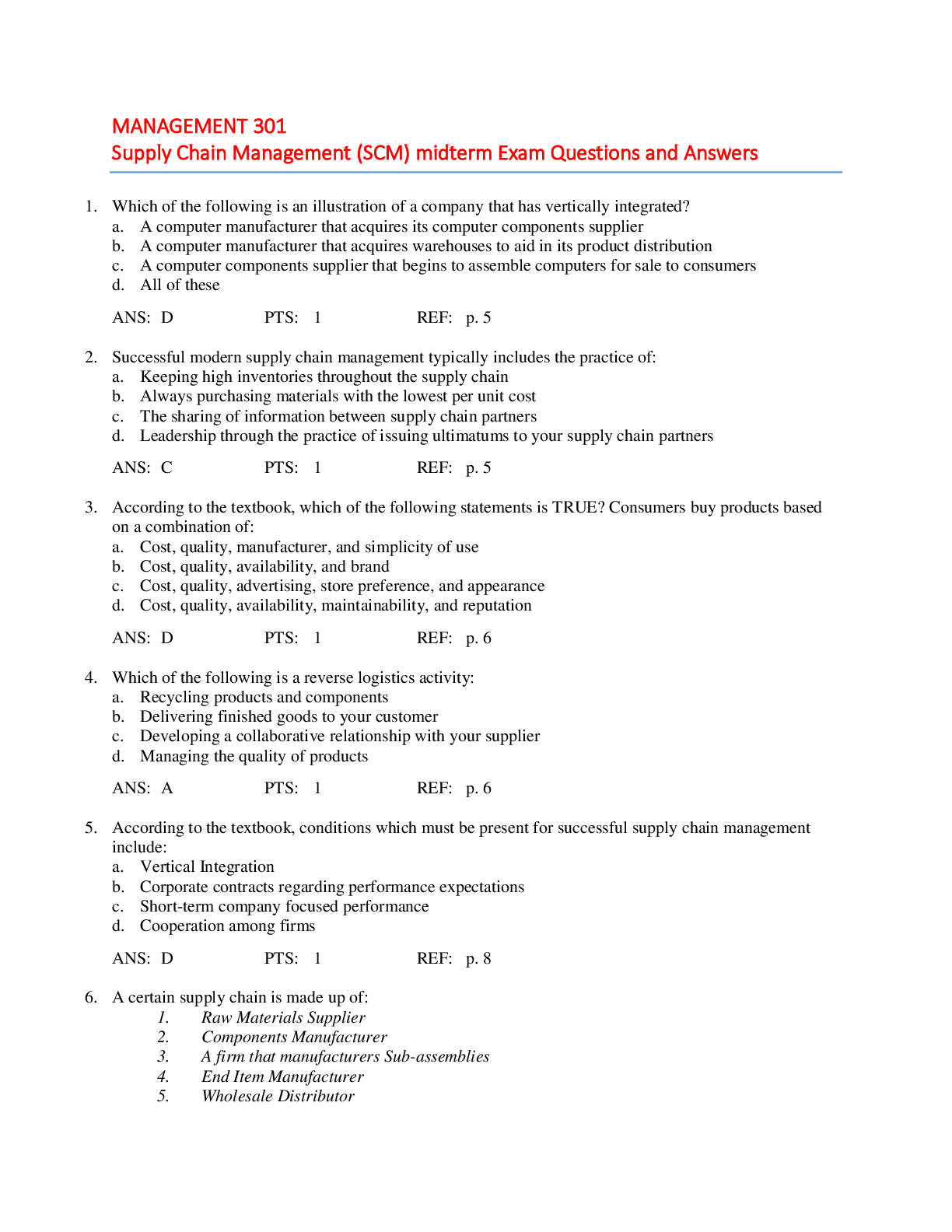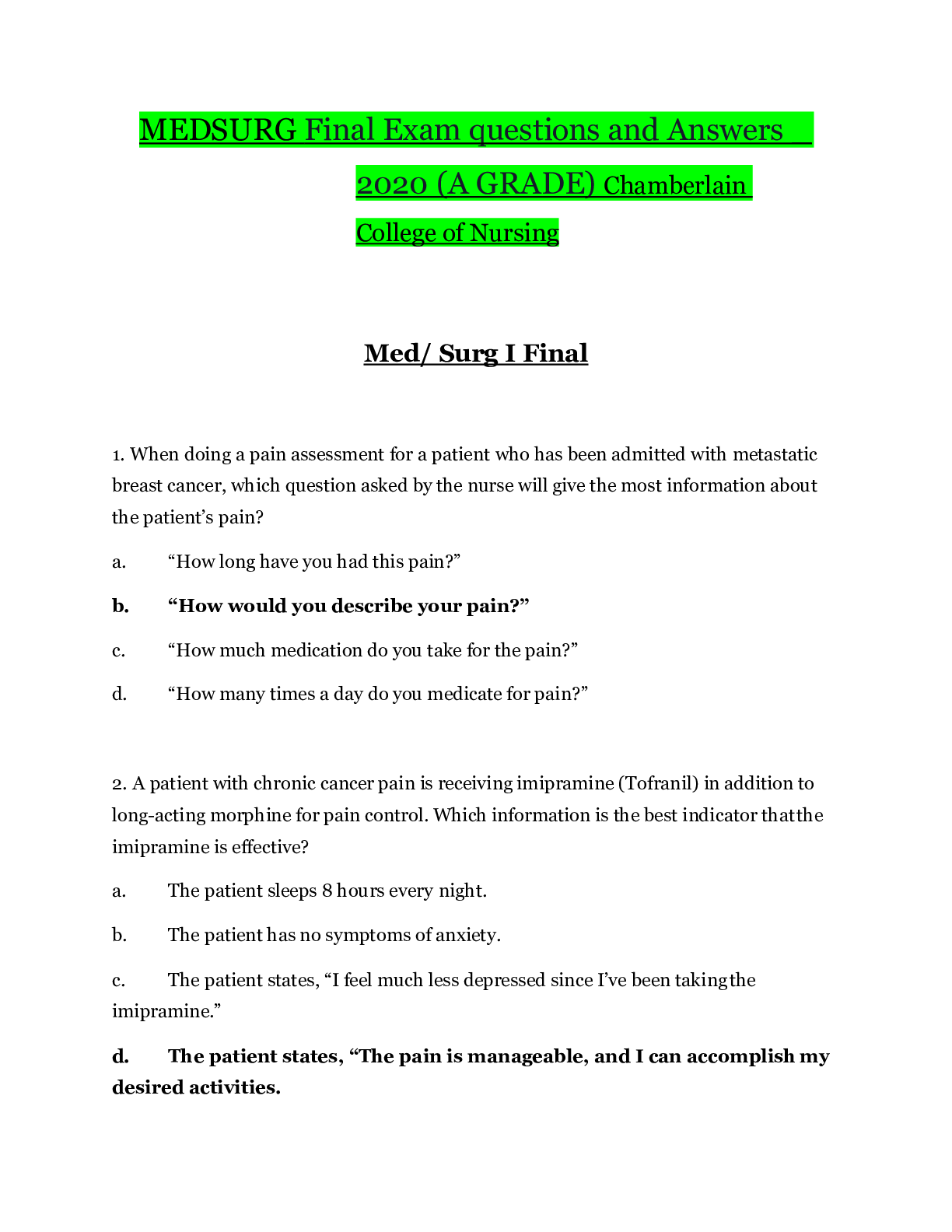*NURSING > QUESTIONS & ANSWERS > Pharmacology Mid-term Exam Questions and answers, 100% proven pass rate. (All)
Pharmacology Mid-term Exam Questions and answers, 100% proven pass rate.
Document Content and Description Below
Pharmacology Mid-term Exam Questions and answers, 100% proven pass rate. Exam 1 - ✔✔15 Questions Your patient works from midnight to 8 AM and experiences insomnia during the day. This is a... n example of which of the following core patient variables? Select one: a. Health status b. Environment c. Life span and gender d. Lifestyle, diet, and habits - ✔✔Feedback The patient's occupation and how his occupation might be affected by drug therapy are documented in the lifestyle, diet, and habits category. The correct answer is: Lifestyle, diet, and habits A client receiving a chemotherapeutic drug for treatment of leukemia asks the nurse why she is receiving a drug that can cause cancer to treat her cancer. The nurse explains... Select one: a. "The carcinogenic effects often do not show up for a few decades, and we want to cure this leukemia now." b. "The incidence of carcinogenic effects is really quite small, and you shouldn't be concerned about it." c. "The risk for causing another cancer is there, but sometimes the benefit of the treatment outweighs the risks." d. "Since you are receiving such potent drugs, they have to warn of you of every possible side effect." - ✔✔Feedback The correct answer is: "The risk for causing another cancer is there, but sometimes the benefit of the treatment outweighs the risks." A 65 year old client's laboratory work indicates hypoalbuminemia. Related to medication therapy, this may result in which of the following? Select one: a. Reduced therapeutic effect b. Decreased medication metabolism c. Prolonged half-life d. Excess free medication and possible toxicity - ✔✔Feedback Decreased levels of albumin lead to decreased binding of medications. This can result in increased levels of the free medication. The correct answer is: Excess free medication and possible toxicity The nurse recognizes that medications can be excreted by the following routes: Select all that apply Select one or more: a. Renal b. Gastric c. Glandular d. Fecal e. Pulmonary - ✔✔Feedback Drugs are primarily excreted by the renal route, but can also be secreted via the lungs (pulmonary), through the feces, and glandularly, such as through breastfeeding or the sebaceous glands. The correct answer is: Renal, Glandular, Fecal, Pulmonary The nurse is caring for a patient receiving an aminoglycoside (antibiotic) that can be nephrotoxic. Which of the following will alert the nurse that the patient may be experiencing nephrotoxicity? Select one: a. Visual disturbances b. Yellowing of the skin c. A decrease in urine output d. Ringing noise in the ears - ✔✔Feedback Decreased urinary output, elevated blood urea nitrogen, increased serum creatinine, altered acid-base balance, and electrolyte imbalances can occur with nephrotoxicity. Ringing noise in the ears (tinnitus) is an indication of possible ototoxicity. Visual disturbances can suggest neurotoxicity, and yellowing of the skin (jaundice) is a sign of hepatotoxicity. The correct answer is: A decrease in urine output On the 1 AM rounds, the nurse finds a patient awake and frustrated that she cannot go to sleep. The nurse administers an ordered hypnotic to help the patient sleep. Two hours later, the nurse finds the patient out of bed, full of energy and cleaning her room. The nurse evaluates the patient's response to the hypnotic as... Select one: a. an allergic reaction b. an idiosyncratic response c. a synergistic effect d. a teratogenic effect - ✔✔Feedback +An idiosyncratic response is an unusual or opposite effect of what is intended. A response of this nature is related to a person's unique response to a drug rather than to the dose of a drug. +An allergic reaction is an immune system response. +A synergistic effect occurs when two or more "unlike" drugs are used together to produce a combined effect and the outcome is a drug effect greater than either drug's activity alone. +A teratogenic effect is a physical defect in the developing fetus caused by a drug or a vaccine that the mother took during pregnancy. The correct answer is: an idiosyncratic response A nurse is caring for a patient who has had part of her small intestine removed due to cancer. She has also now developed hypertension and has been prescribed a new medication to decrease her blood pressure. While planning the patient's care, the nurse should consider a possible alteration in which of the following aspects of pharmacokinetics? Select one: a. Absorption b. Distribution c. Metabolism d. Elimination - ✔✔Feedback A nurse is caring for a patient who has had part of her small intestine removed due to cancer. She has also now developed hypertension and has been prescribed a new medication to decrease her blood pressure. While planning the patient's care, the nurse should consider a possible alteration in which of the following aspects of pharmacokinetics? The correct answer is: Absorption Vistaril given in combination with Talwin diminishes the adverse effects of nausea caused by the Talwin. This drug interaction affecting the pharmacodynamics of the Talwin is... Select one: a. an additive effect b. a synergistic effect c. a potentiated effect d. an antagonistic effect - ✔✔Feedback + An antagonistic drug interaction results in a therapeutic effect that is less than the effect of either drug alone because the second drug either diminishes or cancels the effects of the first drug. + An additive effect occurs when two or more "like" drugs are combined and the result is the sum of the drugs' effects. + A synergistic effect occurs when two or more "unlike" drugs are used together to produce a combined effect and the outcome is a drug effect greater than either drug's activity alone. + Potentiation is an interaction in which the effect of only one of the two drugs is increased. The correct answer is: an antagonistic effect A patient has been prescribed an oral drug that is known to have a high first-pass effect. Which of the following measures has the potential to increase the amount of the free drug that is available to body cells? Select one: a. Giving the drug with food in order to delay absorption b. Administering the drug intravenously rather than orally c. Limiting the patient's protein intake and encouraging fluids d. Administering the drug in small, frequent doses - ✔✔Feedback Unlike oral medications, drugs that are given intravenously do not initially pass through the liver. + As a result, the first-pass effect is mitigated and more of the drug is available to cells. + Frequent oral doses, low protein intake, and administration with food do not reduce the first-pass effect. The correct answer is: Administering the drug intravenously rather than orally An elderly postsurgical patient has developed postoperative pneumonia in the days following abdominal surgery and is being treated with a number of medications. Which of the following medications that the nurse will administer has the slowest absorption? Select one: a. A sublingual benzodiazepine that has been prescribed to help the patient sleep b. An intravenous (IV) antibiotic that is being administered by IV piggyback (IVPB) at 150 ml/hr c. An oral antidepressant that the patient has been taking for several years d. An intramuscular (IM) injection of an opioid analgesic - ✔✔Feedback Absorption of drugs is dependent primarily on the route of administration. IV, IM, and sublingual administration results in faster absorption than drugs that are given orally. The correct answer is: An oral antidepressant that the patient has been taking for several years In which of the following patients would a nurse expect to experience alterations in drug metabolism? Select one: a. A 35 year-old woman with cervical cancer b. A 41 year-old man with kidney stones c. A 50 year-old man with cirrhosis of the liver d. A 62 year-old woman in acute renal failure - ✔✔Feedback The liver is the most important site for drug metabolism. If the liver is not functioning effectively, as with cirrhosis, drugs will not be metabolized normally and toxic levels could develop. + Drug dosage will have to be altered to ensure normal levels in the body. + The patient with kidney stones and the patient in acute renal failure would most likely have alterations in drug excretion. + If there are no complications with the cervical cancer patient, there should be no alterations in drug therapy. The correct answer is: A 50 year-old man with cirrhosis of the liver A 68-year-old female patient who was diagnosed with hypertension 2 weeks ago and was prescribed a new hypertension medication has returned to the clinic for a follow-up visit. The nurse notes that the patient's blood pressure is unchanged from her last clinic visit. When the patient was asked if she was taking the new medication on a regular basis, she stated, "I thought that I was supposed to take the new drug when I had a pounding headache or was in a stressful situation, not all the time." An appropriate nursing diagnosis for this patient would be which of the following? Select one: a. Knowledge, deficient r/t lack of understanding of treatment regimen b. Coping, ineffective r/t forgetfulness c. Confusion, acute conerning drug administration d. Anxiety due to diagnosis of hypertension - ✔✔Feedback Knowledge, Deficient is usually appropriate for a patient who has a new drug prescription and is not fully aware of why he/she is taking the drug or how to appropriately take the drug. Coping, Ineffective relates to a patient who may continually forget to take a drug for a chronic condition. Anxiety could be appropriate for someone who has just been diagnosed with hypertension, but the question does not indicate that the patient is anxious. The correct answer is: Knowledge, deficient r/t lack of understanding of treatment regimen The nurse is using the following formula to calculate pediatric medications: Child's height and weight are plotted on a nomogram, and a line is drawn between the two points. The point at which the line intersects the surface area line is the child's BSA. The dose is calculated as BSA divided by 1.73 X adult dose = child's dose. What does the BSA in the formula represent? Select one: a. The body surface alignment b. The body weight method c. The body surface area d. The body surface attitude - ✔✔Feedback The correct answer is: The body surface area Which classification of drugs is more commonly prescribed for children due to their high incidence of infectious diseases? Select one: a. Respiratory drugs b. Attention-deficit drugs c. NSAIDs d. Cardiovascular drugs - ✔✔Feedback The correct answer is: Respiratory drugs A nurse is going to administer medication to an infant using a medicine dropper. The best method is to open the child's mouth by gently squeezing the cheeks and placing the drops... Select one: a. at the back of the mouth b. in the buccal pouch c. under the tongue d. on top of the tongue - ✔✔Feedback + By placing the medication in the buccal pouch, the child is less likely to spit the medicine out than when placing it under or on top of the tongue and at the back of the mouth. Also, placing the medication in an area other than the buccal pouch could cause aspiration. + By placing the medication in the buccal pouch, the child is less likely to spit the medicine out than when placing it under or on top of the tongue and at the back of the mouth. Also, placing the medication in an area other than the buccal pouch could cause aspiration. The correct answer is: in the buccal pouch Exam 2 - ✔✔15 Questions The client asks the nurse to explain how colchicine works. The nurse would base the response on which physiologic principle? Select one: a. Colchicine increases deposits of uric acid in the synovial spaces of the joints b. Colchicine prevents the accumulation of uric acid crystals in the joints c. Colchicine increases renal secretion of uric acid crystals d. Colchicine relieves the poain associated with joint inflammation from gouty arthritis - ✔✔Feedback Colchicine is a uric acid inhibitor, which prevents the accumulation of uric acid in the blood stream or joint cavities, relieving the symptoms of gout and gouty arthritis. The correct answer is: Colchicine prevents the accumulation of uric acid crystals in the joints Rheumatoid arthritis (RA) is differentiated from osteoarthritis (OA) for which of the following purposes? Select one: a. OA responds to non-pharmacologoc therapy only b. RA responds to pharmacologic therapy only c. There is no need to differentiate because both disease [Show More]
Last updated: 1 year ago
Preview 1 out of 26 pages
Instant download
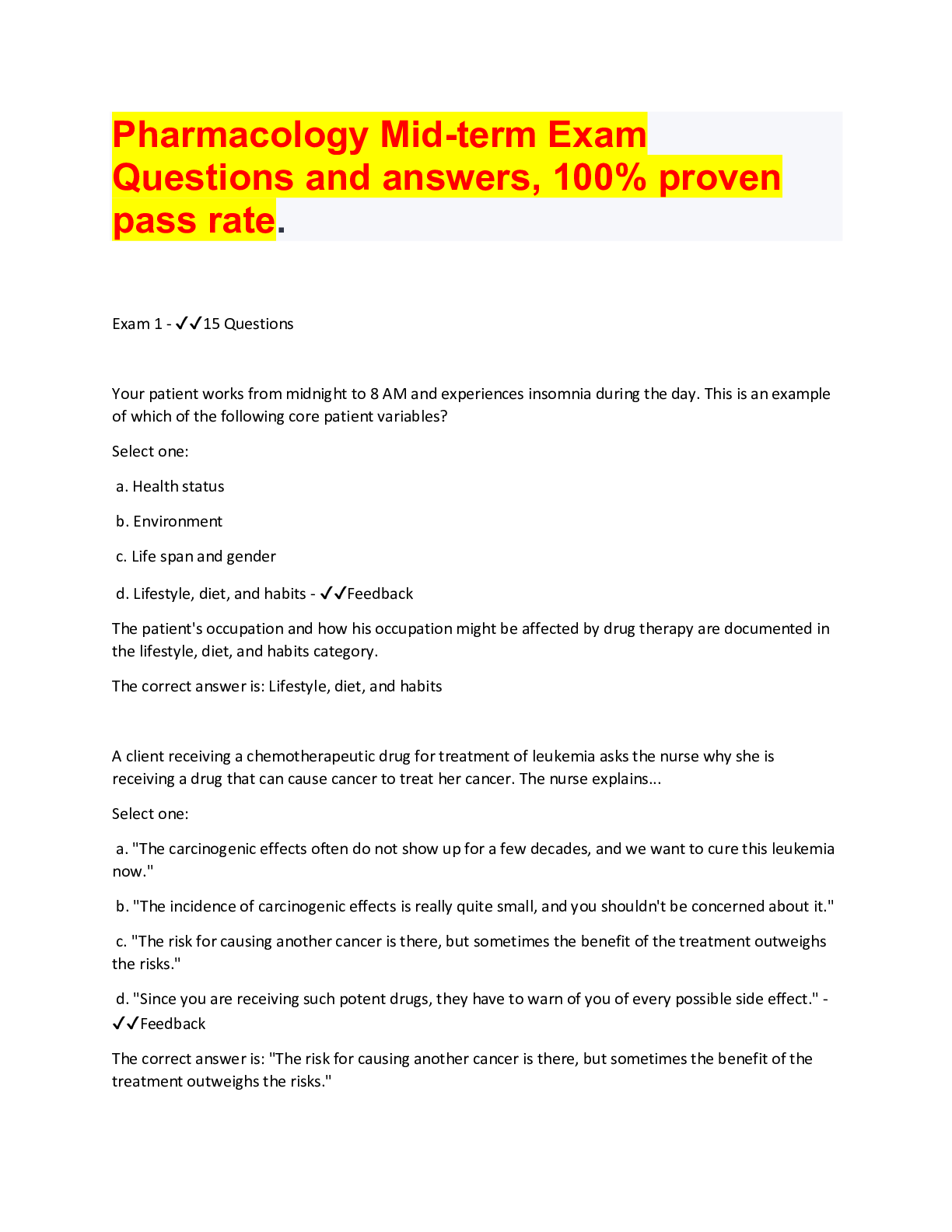
Buy this document to get the full access instantly
Instant Download Access after purchase
Add to cartInstant download
Reviews( 0 )
Document information
Connected school, study & course
About the document
Uploaded On
Aug 20, 2022
Number of pages
26
Written in
Additional information
This document has been written for:
Uploaded
Aug 20, 2022
Downloads
0
Views
161












